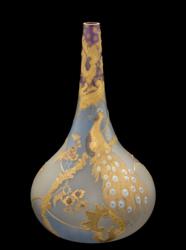Post Time:Apr 15,2011Classify:Industry NewsView:873
 Mt. Washington and Pairpoint glass, which rivaled Tiffany and Steuben in its heyday during the late nineteenth and early twentieth centuries, will be the focus of a major exhibition at The Corning Museum of Glass this year. The exhibition will highlight the changing taste of America’s elite through a broad range of products designed by one of the country’s longest-running art glass companies. On view from May 19 – December 31, 2011, Mt. Washington and Pairpoint Glass: From the Gilded Age to the Roaring Twenties will introduce audiences to this important player in American art glass history.
Mt. Washington and Pairpoint glass, which rivaled Tiffany and Steuben in its heyday during the late nineteenth and early twentieth centuries, will be the focus of a major exhibition at The Corning Museum of Glass this year. The exhibition will highlight the changing taste of America’s elite through a broad range of products designed by one of the country’s longest-running art glass companies. On view from May 19 – December 31, 2011, Mt. Washington and Pairpoint Glass: From the Gilded Age to the Roaring Twenties will introduce audiences to this important player in American art glass history.
Mt. Washington and Pairpoint glass, which rivaled Tiffany and Steuben in its heyday during the late nineteenth and early twentieth centuries, will be the focus of a major exhibition at The Corning Museum of Glass this year. The exhibition will highlight the changing taste of America’s elite through a broad range of products designed by one of the country’s longest-running art glass companies. On view from May 19 – December 31, 2011, Mt. Washington and Pairpoint Glass: From the Gilded Age to the Roaring Twenties will introduce audiences to this important player in American art glass history.
“Although the companies pioneered a range of novel and creative glass styles that experimented with texture, decoration, pattern and color, they have not garnered the same level of recognition as their contemporaries,” says Jane Shadel Spillman, curator of American glass. “Through more than 150 objects, this exhibition will showcase the companies’ role as purveyors of innovative luxury items in a period of exuberant growth and prosperity in the United States.”
The exhibition focuses the companies’ distinctive output from the years 1880-1930:
-Mt. Washington Art Glass: Characterized by innovation in style and technique, Mt. Washington art glass was highly successful commercially and helped cement the company as a leader in American art glass.
-Mt. Washington Cut Glass: Although not a hallmark of the company, Mt. Washington’s elaborate cut glass was fashionable during this period.
-Kerosene and Electric Lamps: Mt. Washington’s lighting business, including gas chandeliers and decorated art glass and cut glass kerosene lamps, was central to their success in the late 19th century. With the invention of the light bulb and the rise of electricity, Pairpoint’s new and visually-striking Electroliers became popular showcases for electric lighting and remained so for nearly thirty years.
-Pairpoint Glass: In the decade prior to the Great Depression, Pairpoint expanded its market offerings with highly-decorative tableware and lighting made of both colored and colorless transparent glass.
The Mt. Washington Glass Company was founded in South Boston in 1837, and moved to New Bedford, Massachusetts, in 1870. In 1880, Thomas J. Pairpoint, an English silversmith, was hired to run the Pairpoint Manufacturing Company, another company in New Bedford which Mt. Washington’s owners established to produce silver-plated mounts for Mt. Washington glass. In 1894, the Pairpoint Manufacturing Company absorbed Mt. Washington and the company was renamed the Pairpoint Corporation in 1900, which remained the company’s name until it went out of business in 1937. It was revived briefly as the Gundersen-Pairpoint Glass Company but closed permanently in 1957.
The Corning Museum of Glass is home to the world’s most comprehensive collection of glass. Spanning the globe and encompassing more than 3,500 years of human ingenuity, the collection includes masterpieces from ancient Egypt, Greece and Rome; the great civilizations of Islam, Asia, Europe and the Americas; and the range of artistic movements beginning in the late 19th century and extending to the present day. Interactive exhibits tell the story of life-changing historic advancements and contemporary innovations in glass technology.
Live glassblowing demonstrations (offered at the Museum, on the road in the U.S. and abroad, and at sea on Celebrity Cruises) bring the material to life for audiences of all ages. Daily Make Your Own Glass experiences at the Museum enable visitors to create their own work in a state-of-the-art hot glassmaking studio.
The Museum’s campus includes a year-round glassmaking school and the Rakow Research Library, the world’s foremost archive and reference collection on the history of glassmaking. A center for scholarship, the Museum also publishes glass-focused periodicals, books and exhibition catalogs.
Located in the heart of the Finger Lakes Wine Country of New York State, the Museum is open daily, year-round. Kids and teens, 19 and under, receive free admission. The Corning Museum of Glass is conveniently located directly off I-86/Rte. 17, mid-way between Niagara Falls and New York City.
Source: http://www.prweb.com/releases/2011/4/prweb8271717.Author: shangyi
PrevReportlinker Adds The Glass Packaging Market 2011-2021
Schott to Offer Large Format Sapphire Glass for Security ApplicationsNext